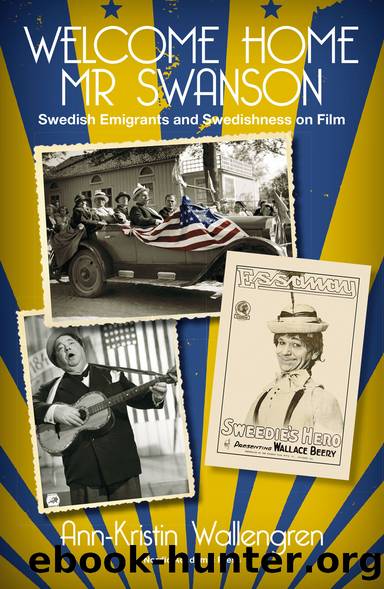Welcome Home Mr Swanson by Ann-Kristin Wallengren

Author:Ann-Kristin Wallengren
Language: eng
Format: epub
ISBN: 9789187675133
Publisher: Nordic Academic Press
Published: 2014-09-08T00:00:00+00:00
Heritage films
Even when they were writing about feature films rather than Sweden films, the newspapers concentrated on the accounts of Swedenâs nature, folklore, festivities, and times gone by instead of a filmâs plot or production values. This was at its most obvious when it came to the films of Swedenâs cinematic golden age, but it remained true long after. For that reason it seems appropriate to call them âheritage filmsâ, although Per Olov Qvist argues that they could equally well be called ârural filmsâ.76 Heritage films are part of the film culture of most nations, and as a genre have been discussed at length by Andrew Higson.77 Such films are made in order to participate in the creation of a common national heritageââa genre of film which reinvents and reproduces, and in some cases simply invents, a national heritage for the screenââand are often based on literary works that are already accepted in the national canon.78 The landscape is a frequent stylistic element in a heritage film: âOne central representational strategy of the heritage film is the reproduction of literary texts, artefacts, and landscapes which already have a privileged status within the accepted definition of the national heritage.â79 Britainâs heritage films, which usually have an aristocratic setting, first took off in 1910s, and were later essential for the British film renaissance of the 1980s and 1990sâthink only of A Room With A View (James Ivory, 1985) and Howards End (James Ivory, 1992). It was the same in France during this period, with Jean de Florette (Claude Berri, 1986) perhaps the prime example.80 This sort of nostalgic film was very popular in France for exactly the same reasons that rural films had once been popular in Swedenâconcerns about modernization and major industrial change, and a wish to recreate a lost era. For Swedish Americans in the US, the heritage films of the 1920s became an important factor in how they remembered Sweden and, crucially, how they wanted to build their new identity.
The first time a Swedish feature film was screened for Swedish Americans in the US was in February 1919, when Victor Sjöströmâs Tösen frÃ¥n Stormyrtorpet was shown in the Aryan Grotto Temple in Chicago.81 It was screened several times over the course of a week, each time with performances by a Swedish vocal trio and accompanied by Meckâs Orchestra. At this time, the advertisements for Swedish film showings in the Swedish American press were often large, with considerable amounts of text and pictures. The advertisement for Tösen frÃ¥n Stormyrtorpet accentuated both its local and Swedish flavour; the title alone breathed nostalgia. Having noted that the film was shot in Dalarnaâthe local elementâit continued âCome and see a genuine Swedish spectacle. Come and see the most beautiful scenery in our old homeland. Come see the simple hut in the wilderness and the affluent farmerâs grand farm. Come see a poignant scene in a Swedish courtroom. Come and see the bridal party in their wedding finery, their boats decorated with leafy branches, and the wedding feast.
Download
This site does not store any files on its server. We only index and link to content provided by other sites. Please contact the content providers to delete copyright contents if any and email us, we'll remove relevant links or contents immediately.
Kathy Andrews Collection by Kathy Andrews(11763)
The remains of the day by Kazuo Ishiguro(8887)
Spare by Prince Harry The Duke of Sussex(5138)
Paper Towns by Green John(5136)
The Body: A Guide for Occupants by Bill Bryson(5027)
Industrial Automation from Scratch: A hands-on guide to using sensors, actuators, PLCs, HMIs, and SCADA to automate industrial processes by Olushola Akande(5024)
Machine Learning at Scale with H2O by Gregory Keys | David Whiting(4258)
Be in a Treehouse by Pete Nelson(3996)
Never by Ken Follett(3877)
Harry Potter and the Goblet Of Fire by J.K. Rowling(3806)
Goodbye Paradise(3760)
Into Thin Air by Jon Krakauer(3346)
The Remains of the Day by Kazuo Ishiguro(3343)
Fairy Tale by Stephen King(3306)
The Cellar by Natasha Preston(3296)
The Genius of Japanese Carpentry by Azby Brown(3254)
120 Days of Sodom by Marquis de Sade(3223)
The Man Who Died Twice by Richard Osman(3040)
Drawing Shortcuts: Developing Quick Drawing Skills Using Today's Technology by Leggitt Jim(3036)
